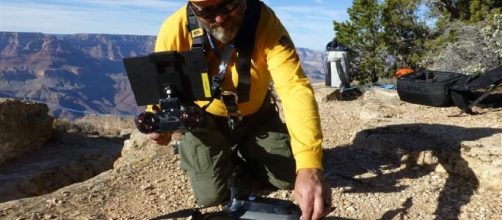The Grand Canyon is reportedly the only national park currently owning its own fleet of five drones, along with four certified operators. The unmanned aircraft were put to the test recently after two hikers went missing at the bottom of the Grand Canyon. The drones were introduced to the national park last fall, to be used to locate people who are stranded, lost or injured.
Grandmother and step-grandson missing in the Grand Canyon
The drones were used by the park rangers from Monday through Wednesday last week while searching for LouAnn Merrell, 62, who went missing with her step-grandson, 14-year-old Jackson Standefer, last weekend after they lost their footing crossing a creek close to the North Rim.
Merrell and Standefer were reportedly enjoying a hike with Merrell’s husband, Randy, along with Jackson’s mother at the time.
NEW THIS MORNING: National Park Service scales back search for missing hikers in Grand Canyon https://t.co/JeQQz8Tf9b
— WTVC NewsChannel 9 (@newschannelnine) April 20, 2017
According to a report by the Chicago Tribune, three ground search teams of around 20 people were also sent out, along with a helicopter and an inflatable motor boat. However, after the drones were not able to find the pair, rangers scaled back the search operation using the unmanned aircraft, but did continue the search. Reportedly the hikers’ families agreed with the park’s decision, saying they were "still praying for a miracle."
While the Grand Canyon – which covers an area of almost 2,000 square miles – offers incredible views, it can also be very dangerous for visitors.
ABC News reports that during 2016, rangers had to deal with 1,200 medical emergencies in the canyon, along with 293 search-and-rescue missions. 17 people reportedly died in the canyon last year, including a Yelp executive who tripped and fell backwards while hiking and was found 400 feet below.
Search highlighted the benefits of using drones in the Grand Canyon
While it turned out the current aerial search of the area came up empty, the use of the drones did highlight how the technology can access crevices and other difficult spots which are not easy to reach on foot. They also spare the search party from the inherent dangers of going up in a helicopter.
Effort to find hikers in Grand Canyon was the most extensive use yet of drones in a search-and-rescue mission https://t.co/2DJpXZU7XY pic.twitter.com/3EaHHJBTx6
— 3TV Phoenix (@azfamily) April 22, 2017
Grand Canyon chief ranger Mark Vandzura says that historically, they always took up the helicopter when performing a search, but he says using drones gives the same close look, without putting rangers at any risk.
Vandzura reckons the use of the drones has “dramatically increased” their ability to keep their rangers safe. Reportedly drone operators are able to watch the drones’ video footage in real time and then, at the end of the day, to analyze it again.
Drones have been used before in the Grand Canyon
While this is the first time the drones have been used to search for missing hiker, it isn’t the first time the park rangers have used the unmanned aircraft. Reportedly after a visitor accidentally drove off a cliff in November and died, drones were used to examine the brush and trees to ensure it would be safe for a helicopter to fly in to lift the vehicle out of the canyon. A drone was also used in December to find the body of a woman who jumped to her death in the Grand Canyon.
On finding her body, rangers were then able to rappel down to retrieve it.
Other parks do reportedly use drones, but only currently for wildlife research. According to James Doyle, spokesman for the National Park’s services Intermountain region, other national parks will likely seek their own fleets of drones. However, he added that the extreme topography in the Grand Canyon makes that park the perfect candidate. The use of private drones in the park is, however, prohibited.

